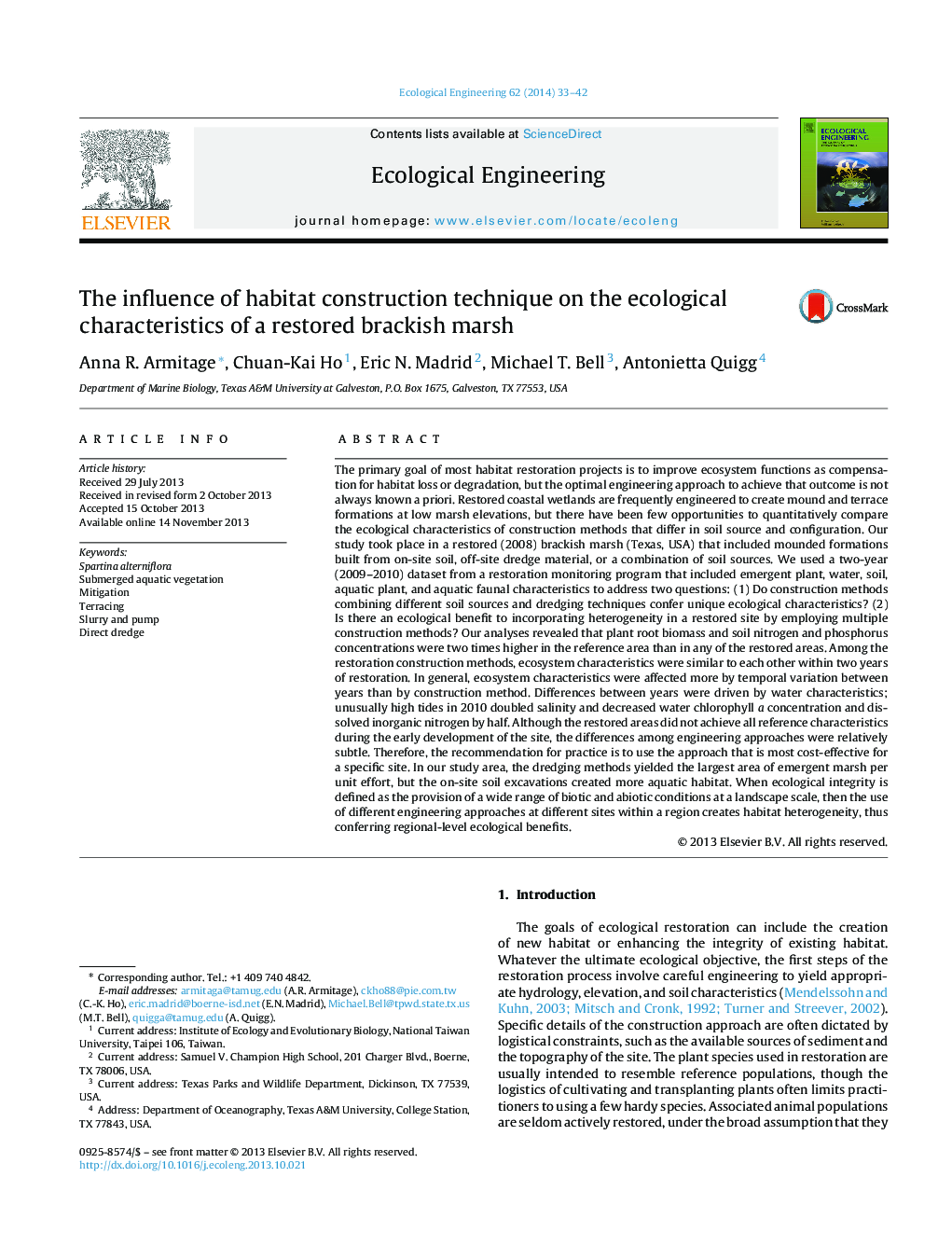| کد مقاله | کد نشریه | سال انتشار | مقاله انگلیسی | نسخه تمام متن |
|---|---|---|---|---|
| 6302240 | 1618037 | 2014 | 10 صفحه PDF | دانلود رایگان |
عنوان انگلیسی مقاله ISI
The influence of habitat construction technique on the ecological characteristics of a restored brackish marsh
ترجمه فارسی عنوان
تأثیر روش ساخت و ساز زیستگاه بر ویژگی های اکولوژیکی جنگل مرطوب بازسازی شده
دانلود مقاله + سفارش ترجمه
دانلود مقاله ISI انگلیسی
رایگان برای ایرانیان
کلمات کلیدی
ترجمه چکیده
هدف اولیه اکثر پروژه های بازسازی زیستگاه بهبود عملکرد اکوسیستم به عنوان جبران زیان زیستگاه و یا تخریب، اما روش مهندسی بهینه برای رسیدن به این نتیجه همیشه پیش فرض شناخته شده نیست. تالاب های ساحلی بازسازی شده اغلب برای ساخت تپه ها و تراس ها در ارتفاعات کم ارتفاع مهندسی شده اند، اما فرصت کمی برای مقایسه ویژگی های اکولوژیکی روش های ساخت و ساز که در منبع خاک و پیکربندی وجود دارد متفاوت است. مطالعه ما در یک جنگل سیب دار بازسازی شده (2008) (تگزاس، ایالات متحده آمریکا) انجام شد که شامل سازند های سنگی ساخته شده از خاک در محل، مواد غرق در خارج از محل یا ترکیبی از منابع خاک بود. ما از یک مجموعه داده های دو ساله (2009-2010) از یک برنامه نظارت مرمت استفاده کردیم که از جمله گیاهان، آب، خاک، گیاهان آبزی و ویژگی های فیزیکی آبزی است که به دو سوال پاسخ می دهد: (1) آیا روش های ساخت و ترکیب منابع مختلف خاک و گودبرداری تکنیک های منحصر به فرد ویژگی های زیست محیطی (2) آیا با استفاده از چند روش ساخت و ساز، یک مزیت زیست محیطی برای ترکیب ناهمگونی در یک سایت بازسازی شده وجود دارد؟ تجزیه و تحلیل های ما نشان داد که بیوماس ریشه گیاه و غلظت نیتروژن خاک و فسفر در منطقه مرجع دو برابر بیشتر از هر منطقه بازسازی شده است. در میان روش های ساخت و ساز ترمیم، ویژگی های اکوسیستم در طی دو سال از بازسازی مشابه یکدیگر بود. به طور کلی، ویژگی های اکوسیستم توسط تغییرات زمانی بین سال ها بیشتر از روش ساختمانی تحت تاثیر قرار گرفت. تفاوت های بین سال ها بر اساس ویژگی های آب بود؛ غلظت بالا در سال 2010 شوری دو برابر و کاهش کلروفیل آب یک غلظت و نیتروژن غیر آلی را به نصف کاهش می دهد. اگر چه مناطق بازسازی شده در تمام مراحل اولیه توسعه سایت به تمام ویژگی های مرجع دست نیافتند، تفاوت در روش های مهندسی نسبتا ظریف بود. بنابراین، توصیه برای عمل این است که از رویکردی که برای یک سایت خاص مناسب است، استفاده شود. در ناحیه مطالعه ما، روش های لایروبی، بزرگترین ناحیه جنگل های سرخدار را در هر واحد واحد به دست آوردند، اما کاوش های خاک در محل، بیشتر زیستگاه های آبزی را ایجاد کردند. هنگامی که یکپارچگی زیست محیطی به عنوان تهیه طیف گسترده ای از شرایط زیستی و زیستی در یک مقیاس منظر تعریف می شود، استفاده از رویکردهای مختلف مهندسی در مکان های مختلف در یک منطقه باعث ایجاد ناهمگنی زیستگاه می شود، بنابراین مزایای زیست محیطی در سطح منطقه را تضمین می کند.
موضوعات مرتبط
علوم زیستی و بیوفناوری
علوم کشاورزی و بیولوژیک
بوم شناسی، تکامل، رفتار و سامانه شناسی
چکیده انگلیسی
The primary goal of most habitat restoration projects is to improve ecosystem functions as compensation for habitat loss or degradation, but the optimal engineering approach to achieve that outcome is not always known a priori. Restored coastal wetlands are frequently engineered to create mound and terrace formations at low marsh elevations, but there have been few opportunities to quantitatively compare the ecological characteristics of construction methods that differ in soil source and configuration. Our study took place in a restored (2008) brackish marsh (Texas, USA) that included mounded formations built from on-site soil, off-site dredge material, or a combination of soil sources. We used a two-year (2009-2010) dataset from a restoration monitoring program that included emergent plant, water, soil, aquatic plant, and aquatic faunal characteristics to address two questions: (1) Do construction methods combining different soil sources and dredging techniques confer unique ecological characteristics? (2) Is there an ecological benefit to incorporating heterogeneity in a restored site by employing multiple construction methods? Our analyses revealed that plant root biomass and soil nitrogen and phosphorus concentrations were two times higher in the reference area than in any of the restored areas. Among the restoration construction methods, ecosystem characteristics were similar to each other within two years of restoration. In general, ecosystem characteristics were affected more by temporal variation between years than by construction method. Differences between years were driven by water characteristics; unusually high tides in 2010 doubled salinity and decreased water chlorophyll a concentration and dissolved inorganic nitrogen by half. Although the restored areas did not achieve all reference characteristics during the early development of the site, the differences among engineering approaches were relatively subtle. Therefore, the recommendation for practice is to use the approach that is most cost-effective for a specific site. In our study area, the dredging methods yielded the largest area of emergent marsh per unit effort, but the on-site soil excavations created more aquatic habitat. When ecological integrity is defined as the provision of a wide range of biotic and abiotic conditions at a landscape scale, then the use of different engineering approaches at different sites within a region creates habitat heterogeneity, thus conferring regional-level ecological benefits.
ناشر
Database: Elsevier - ScienceDirect (ساینس دایرکت)
Journal: Ecological Engineering - Volume 62, January 2014, Pages 33-42
Journal: Ecological Engineering - Volume 62, January 2014, Pages 33-42
نویسندگان
Anna R. Armitage, Chuan-Kai Ho, Eric N. Madrid, Michael T. Bell, Antonietta Quigg,
